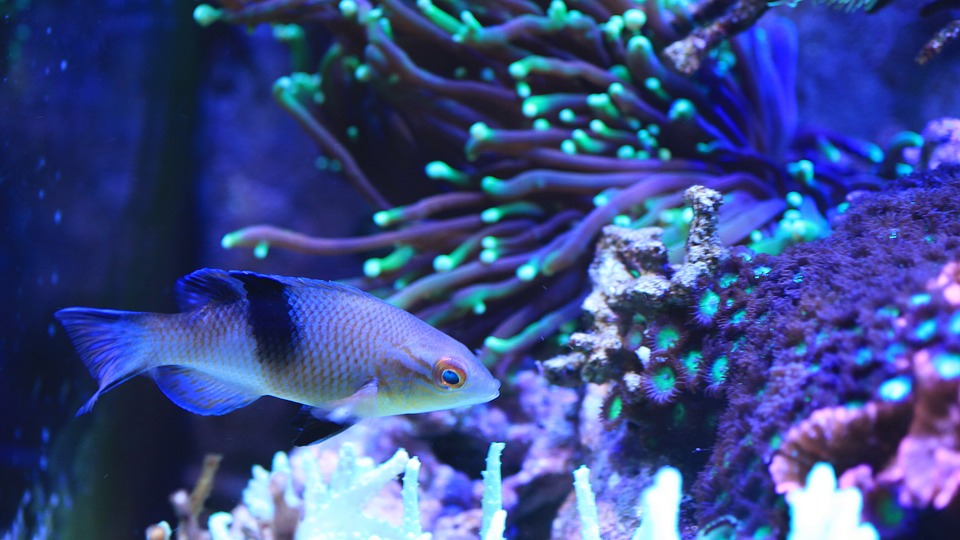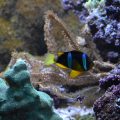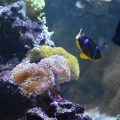Table of Contents
Tangs are also known as blue saltwater fishes. The family Acanthuridae includes the Tangs and the Unicornfish (which have a unique horn-like appendage that grows from the front of their heads); this family name literally means “thorn tail” which refers to the defensive scalpel-like blades on either side of the base of the tail; also called a tang (blue saltwater fish), which flare out when the fish feels threatened. These blades are very sharp and have cut many saltwater hobbyists not handling them carefully; so beware of the base of the tail of blue saltwater fish.
Thorn Tail
Blue saltwater fishes are also known as Tangs. The family Acanthuridae includes the Tangs; and the Unicornfish (which have a unique horn-like appendage that grows from the front of their heads); this family name literally means “thorn tail” which refers to the defensive scalpel-like blades on either side of the base of the tail; also called a tang, which flare out when the fish feels threatened. These blades are very sharp and have cut many a saltwater hobbyist not handling them carefully; so beware of the base of the tail of Tangs.
Blue Saltwater Fish Size
Most blue saltwater fish species grow quickly to an adult size of 15 to 40 cm in length depending on species; some Unicorn fish grow to more than 3 feet; so check the full grown size of the Tang because you need to ensure that you will have enough space. They also like to have their own hiding places. Some species of Tangs are hardy but some are also relaxed in the marine aquarium. Other species vary in their temperament and they can be fussy, tricky to care for, and also delicate. Generally, Tangs enjoy being the dominant alpha saltwater fish in your aquarium; and they also like to take up the spotlight!
Tips for Keeping Them Healthy
Tip #1:
If you want your blue saltwater fishes to feel happy and safe; you need to provide an aquarium that’s around 75 gallons in volume because these species are active swimmers. They love hiding places and enjoy playing tag, hide and seek, and loves messing with the other fish’s heads.
Tip #2:
Blue saltwater fishes are best kept alone to a tank but if you want to add more it’s best to keep them with their own kind; or at least keep individuals that are as different looking in order to avoid any aggression. If you want to keep multiple blue saltwater fishes then make sure that your system is 100 gallons or bigger; and it should ideally have plenty of hiding places so that they can get out of each other’s line of sight and avoid trouble.
Tip #3:
New blue saltwater fishes are very prone to parasitic disease possibly because of their tiny – scaled leathery skin; but also because they don’t handle shipping very well. You definitely should quarantine a new Tang for at least 30 days before introducing it into your display tank. After that a good diet of macro – algae and clean, regularly maintained water should keep them disease free.
Tip #4:
Since fish primary feeds on macro-algae, one great way to feed them is to cultivate macro – algae species in your sump or refugium (or even the display tank); when it’s not being used to fuel your Tangs’ shenanigans as well as filter the water and make it free from algae and pollutants such as nitrates and phosphates.
Tip #5:
Tangs are quite active and therefore prefer highly oxygenated water; which is why you need to make sure you have a combination of multiple powerheads; airstones and surface agitation that can provide a multi – directional water flow. This will keep your tangs very happy.
Tip #6:
Tangs primarily eat macro – algae in the wild; if you want to keep them in the best condition, then you should vary their diets often. For example, you can do so, by adding regular fresh lettuce, sushi nori, and occasionally meaty foods to their usual meals. You can use a veggie clip to attach veggies in the tanks for them.
A Tang’s belly should appear round after feeding them. Keep in mind that they need to be fed a lot since they are active, and can only get relatively low nutrients from their veggie foods. Tangs also really love rocks as they can graze the algae off it. So having lights that promote algae growth will keep your Tangs optimally happy.
Tip #7:
It is very easy to get fish caught in your net due to their spines, ensure your net has very fine mesh or very large mesh to avoid ripping their scalpels. If your Tang is stuck just gently move the net forward and back in the water, eventually the fish will relax its spines and swim out. Alternatively you can use a jar or container to catch them.
Tip #8:
Major Tang aggression can easily result in a fish literally sliced to pieces, so make sure you do your homework when it comes to fish compatibility! Timid fish species will usually be very stressed by Tangs. Often pair of any Tang species will be highly aggressive toward each other and fight, keep a single fish or a group if your tank is big enough.
Best Fishes for Saltwater Aquariums
Not all fishes are easy to care for, some are even a mistake for the beginner to attempt, but all are stunning to look at and are loaded with personality. The two best fishes are Powder Blue Tang and Regal Tang.
Powder Blue Tang
One of the most gorgeous fish in a saltwater aquarium is the powder blue tang. It is a powder blue body with yellow dorsal fins and black head and white highlights. However, it is expensive and prone to parasitic infection and intolerant of any other Acanthurus tangs. Keep one to a tank and only keep other tangs with it if your tank is really big, even then it may be pretty aggressive.
It is reef compatible, grows to about 9 inches and is classed as semi-aggressive, you need to keep this fish in a system that’s about 125 gallons with good water quality. Feed lots of many types of veggies to boost immune response and help keep aggression to a minimum, it will also take shellfish and shrimp. Take time acclimating and quarantining this fish to avoid Ich. This fish is not for beginners but will be a stunning addition to your tank.
Regal Tang
This Tang likes to wedge itself in coral and lie on its side when sleeping, so don’t be alarmed if you witness this behavior! It is important to keep an eye on Regals as they are also prone to skin parasites, but they are quite hardy when acclimated correctly. Regal Tangs are some of the most active swimmers in the Tang family so you’ll need a larger tank. They also love to have their own privacy in a hiding place when they’re not curiously roaming their environment. They are peaceful toward their tank mates, but will be aggressive towards other Regal tangs. These fish are great choices for large community tanks because of their peaceable nature; they are probably the most peaceful of all Tangs.






 Author and long-time animal lover. Sharing knowledge on pet care through experience and the written word.
Author and long-time animal lover. Sharing knowledge on pet care through experience and the written word.